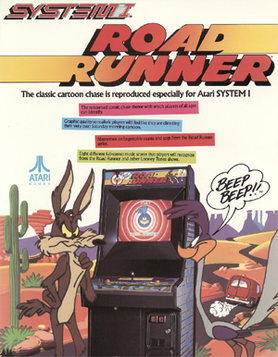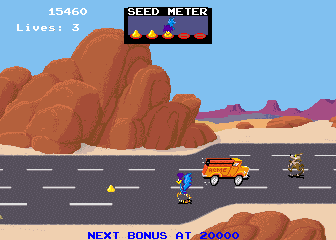
Road Runner
|
 
|
||||||||||||||||||||||||||||||||||||||||||
| Werbetext (englisch) |
|
Game play with outstanding entertainment value! The player portrays the Road Runner who must avoid Wile E. Coyote and his tricks white eating seed along the way in order to stay alive. In later game screens the challenge intensifies; there are trucks to dodge, lemonade to drink, steel shot to eat and invisible paint to use. A brand new control, the hall-effect joystick, guides both the speed and the direction of movement of the Road Runner. The hall-effect device responds in all directions and positions (not just the standard four or eight), giving the player a full range of speed and movement. Timing the use of the hop button is critical for the Road Runner to out-manoeuver Wile E. Coyote. The player must learn to jump over mines, oil slicks, crevices and steel shot. The entertainment value of Road Runner is highlighted as the player is encouraged to take risks for a high score by picking up the piles of seed, teasing Wile E. Coyote (allowing him to follow closely), forcing the coyote's plans to backfire, jumping over the mines, eating the steel shot and drinking the lemonade. Operator Options for maximizing earnings! The operator can select from four difficulty settings, four different starting life options, four options for maximum number of bonus lives, and eight different options for bonus threstold. All of the standard, high-level System I self-test and game statistics features are included. Special statistic features for Road Runner include a reading of the numbers of players who have used the short cut (game continuation feature), the total number of bonus lives awarded for all games ad the number of players who have achieved the maximum number of bonus lives allowed. For operators who would like to utilize prize redemption, Road Runner also features the new System I Vend-A-Ticket game option. |
| Trivia |
|
Es waren bereits zwei Arcadespiele gleichen Namens geplant. Die erste Version sollte bereits Anfang der 1980er Jahre erscheinen, kam jedoch nicht auf den Markt. Die zweite, ebenfalls nicht erschienene Version war für 1984 geplant und sollte mit Laserdisc ausgestattet werden. Das 1986 erschienene Spiel ist eine Weiterentwicklung dieser zweiten Version. Das Spiel basiert auf der Cartoonreihe Wile E. Coyote and the Road Runner, die seit 1949 Teil der Looney Tunes-Serie von Warner Bros. ist. Neben den NES- und 2600-Versionen wurde Road Runner auch auf Amstrad/Schneider CPC, Atari ST, Commodore 64, MS-DOS und Sinclair ZX Spectrum portiert. Bei der Musik griff man auf bekannte Stücke zurück. Im ersten Level ertönt die Ouverture del Guglielmo Tell von Gioachino Rossini aus dem Jahr 1829, im zweiten Level Полёт шмеля (dt.: Hummelflug; Nikolai Rimsky-Korsakow, 1900). Im dritten Level wird Трепак (Trepak, Teil des Märchenballetts Щелкунчик/Der Nussknacker; Pjotr Iljitsch Tschaikowski, 1892), und im vierten Level sowie im Attract Mode Սուսերով պար (Säbeltanz, Teil des Balletts Գայանե/Gayane, Aram Khachaturian, 1942). |
| Konsolenumsetzungen von Atari und Tengen |
|
▶ Road Runner (Atari 2600) ▶ Road Runner (Nintendo Entertainment System) |
| ◀ Road Runner (1984) | RoadBlasters ▶ |